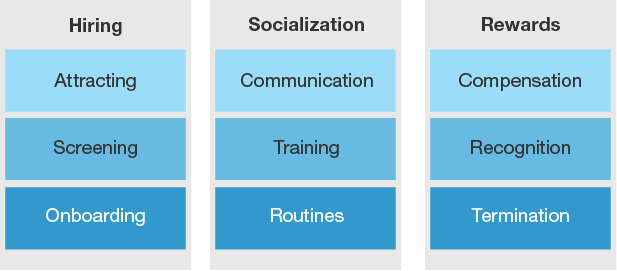How To Build A Customer-Centric Culture
In my latest report, "How To Build A Customer-Centric Culture," I describe how customer experience professionals use three tools to embed customer focus in their organizations:
- Hiring. Firms need to attract customer-centric candidates, screen out applicants who lack customer focus, and onboard new employees in a way that reinforces their customer-centric DNA.
- Socialization. Companies must communicate their intended experience vision, train employees to deliver the intended experience, and reinforce customer focus with routines.
- Rewards. Organizations should use both formal and informal incentives that reward employees for behaviors that lead to better customer experience outcomes.

Companies that successfully combine these three tools shape organizational cultures that make it easy for all employees to focus on customers and deliver great experiences. For example:
- Hire employees that align with your organization's customer-centric vision. This starts with attracting applicants with customer-centric values. One of the best examples of this I've seen comes from The Container Store. Its careers website describes its commitment to putting employees first to enable them to "take better care of customers." Once companies attract the right candidates, they need to also screen them for customer-centric behaviors. The best way to do this is to get candidates to share examples from their past experiences that relate to critical behaviors or competencies in the roles. Saskatchewan Government Insurance (SGI) does this particularly well. It trains all hiring managers in behavioral interview techniques and then listens for evidence from candidates that exemplify its core competencies. The last step to hire customer-centric employees is to onboard them in a way that reinforces their customer-centric attributes. To do this, more and more companies use learning maps: visual representations of existing or desired states that facilitate training and coaching sessions. Learning maps bring the customer experience vision to life and help all employees — but new hires in particular — connect their role and responsibilities to the intended experience.
- Socialize customer focus with all employees. Companies can't just change who walks in the door. They also need to help current employees change their behaviors to be more customer-centric. Corporate communications are a critical component. Companies need to describe what the intended experience is and how employees will contribute. They also need to train employees to deliver the intended experience. For example, when Cleveland Clinic set out to transform its culture to deliver great patient experiences, it trained all 42,000 employees in its patient experience principles. And finally, companies should create routines that remind employees to focus on delivering great customer experiences. Ritz-Carlton's Daily Lineup is a great example.
- Reward customer-centric behavior with compensation and recognition. Companies must reinforce customer centricity by linking compensation and recognition to employee performance on customer-centric behaviors. Some companies, for example, have embedded their customer experience principles into employee evaluations and use them to determine the size of merit increases and bonuses and which employees get promoted. And informal rewards and recognition are important as well. Kudos from senior executives or from peers reinforce customer-centric behaviors. The positive reinforcements have a flip side, though. Unfortunately, some employees can't or won't change their behaviors. When Office Depot transformed its culture to be more customer-centric, it helped find new jobs for retail employees who disliked interacting with customers.
For more information, see the full report. My research into customer-centric culture is also reflected in a few other reports that complement and deepen this report:
- "How To Hire And Onboard Customer-Centric Employees" provides more detail and examples about modifying hiring processes.
- "Communication, Training, And Routines: How Companies Socialize Customer Centricity" expands on the second culture pillar.
- "Drive Customer-Centric Employee Behavior With Rewards And Recognition" looks at how companies actually determine which employee behaviors deliver the best customer experience outcomes and how to reward and incent employees for consistently performing those behaviors.
Please share your favorite examples of customer-centric culture in the comments below.